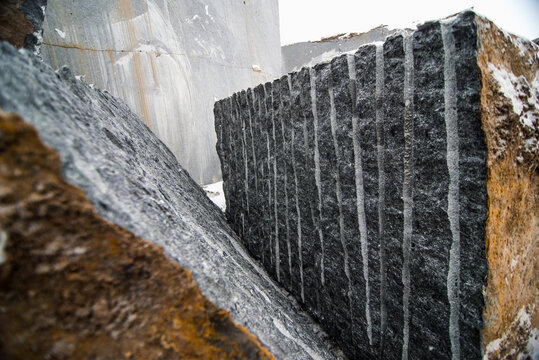The Hidden Treasures: Discovering Granite Quarries in South Africa
The Hidden Treasures: Discovering Granite Quarries in South Africa
Blog Article
Unearthing the Rich History and Lasting Practices of Granite Quarrying
As we stand on the precipice of revealing the elaborate tapestry of granite quarrying, a trip through time exposes not just the physical act of removing stone yet likewise the social and historical value woven into the really fabric of this technique. From the ancient beginnings that laid the foundation for contemporary quarrying techniques to the lasting practices that are forming the future of this industry, each sculpt mark on granite surfaces tells a story waiting to be unearthed (granite quarries in south africa). The tradition of granite quarrying extends much beyond plain removal; it is a testament to human ingenuity, strength, and the enduring appeal of this marvelous stone
Old Beginnings of Granite Quarrying
Dating back to ancient worlds, the practice of quarrying granite has been an essential component of human background and building development. The earliest proof of granite quarrying days back to old Egypt, where large pyramids and elaborate sculptures were crafted from this long lasting stone. The Egyptians made use of primitive tools to draw out granite blocks from quarries, showcasing the importance of this product in their huge building and constructions.
Moving on in history, the Greeks likewise made substantial contributions to the quarrying of granite. The Greeks used granite in various architectural wonders, such as temples and statuaries, demonstrating their ability in shaping and carving this sturdy stone. The Romans better refined the methods of quarrying granite, using sophisticated devices like knives and hammers to essence and shape granite for their iconic structures.
With the centuries, the method of quarrying granite has developed, with modern innovations enhancing performance while maintaining the ageless charm of this natural rock - granite quarries in south africa. From ancient worlds to modern builders, the tradition of granite quarrying remains to shape our world
Advancement of Quarrying Methods
The evolution of quarrying techniques has actually been noted by a continuous progression in the direction of greater performance and precision in extracting granite. From the basic approaches employed by our ancestors to the advanced modern technologies utilized in modern quarrying procedures, the market has undergone substantial innovations. Early quarrying methods entailed hands-on labor with fundamental tools such as chisels, hammers, and wedges to extract granite blocks from the earth. As civilizations proceeded, methods like fire-setting and primitive dynamites were presented to assist in the removal procedure.
In more current times, the advent of equipment reinvented the quarrying market, enabling quicker extraction prices and enhanced performance. Technologies such as diamond wire saws, high-pressure water jets, and pneumatic drills have ended up being typical in modern quarries, enabling accurate cutting and lowered waste. Advancements in computer-controlled equipment and 3D modeling have actually enhanced quarrying operations, leading to minimal environmental influence and enhanced sustainability techniques. As the demand for granite continues to rise, the advancement of quarrying methods continues to be integral to conference sector needs effectively and sustainably.
Social Significance of Granite
Granite holds an extensive social importance across various civilizations because of its enduring existence in architectural work of arts and admired monoliths. From the impressive pyramids of Egypt to the intricate carvings of the Angkor Wat temple in Cambodia, granite has actually been a product view of selection for revealing magnificence and longevity in cultural heritage. In ancient Rome, granite columns decorated holy places and public structures, look at these guys representing stamina and permanence. The social importance of granite extends past its physical qualities; it symbolizes resilience, security, and timelessness, making it an icon of withstanding legacies and practices.

Sustainable Practices in Quarrying
Amidst the abundant history of granite quarrying and its social value exists a growing focus on lasting methods within the industry. As ecological awareness and issues about resource deficiency have heightened globally, the quarrying sector has actually significantly accepted sustainable methods to lessen its effect on the setting and bordering neighborhoods.

In addition, recovery and recovery of quarry websites post-extraction are important to sustainable methods. By restoring quarried areas to a natural or beneficial state, such as creating wild animals environments or leisure areas, quarriers can offset the environmental impact of their procedures and contribute positively to the neighborhood ecological community.
Heritage of Granite Quarrying
With a historic backdrop steeped in workmanship and commercial development, what withstanding impact has granite quarrying left on the landscape of modern culture? The tradition of granite quarrying goes beyond plain removal methods; it has formed architectural marvels, city landscapes, and social heritage worldwide. The resilient nature of granite has actually made it a favored option for monoliths, structures, and infrastructure, standing as a testimony to the skill and artistry of quarry employees across generations.
Furthermore, the financial footprint of granite quarrying can not be overlooked. The sector remains to provide employment possibility and drive local economic situations in areas where granite extraction is widespread. It has additionally spurred technical improvements in quarrying techniques and devices, leading to extra efficient and lasting practices.
In regards to sustainability, the heritage of granite quarrying includes initiatives to mitigate environmental influences through improvement jobs and responsible resource administration. By stabilizing financial interests with environmental stewardship, the market makes every effort to make certain that future generations can continue to take advantage of this long-lasting natural deposit.
Conclusion

Report this page